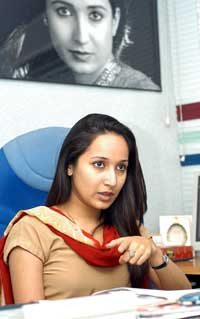
Srijana Thapa is the 26-year-old director of Photo Concern, one of Nepal's first photo labs. She talks to Nepali Times about the photography industry and her family's pioneering role.
Nepali Times: Photo Concern is a family business, how did it get started?
Srijana Thapa: My grandfather DB Thapa was a royal photographer and established the business in 1960. It was in Calcutta that he became interested in photography, but there were no photography services or equipment here then. People used to take colour rolls to Hong Kong to develop. So, he started a small studio downstairs. He started developing colour photographs manually and in the 1970s he got a mini lab. Bringing the machine in was itself a big challenge. It cost Rs 8-9 lakh and no one wanted to help with co-investing. Everyone thought there was no market.
Isn't quality control a real problem?
Quality depends on many factors: the camera, the photographer, people behind the printing machine, the machine itself. Most of our lab technicians have been trained in India and have 12-15 years experience so they are well acquainted with the whole process. We don't compromise on quality. As far as the paper and chemicals are concerned, we use only Kodak. Some labs cut corners and dilute their chemicals.
They call it the 'photo lab syndrome': the Nepali propensity to copy someone else's success.
The photo lab business really picked up 10-12 years ago. Now, it's pretty saturated and stable. We now have 117 Kodak Express Labs in Nepal out of the total 240 labs. The business is growing daily. Our main outlet processes 50,000 rolls a month and from each roll we give Rs 2 to the Nepal Cancer Relief Society. That comes to Rs 100,000 a month.
Going digital hasn't affected business?
Four years ago we brought in the first professional LED digital lab. It gives a uniform colour tone. We have three of the top digital cameras including Fuji's S2 Pro with 12.1 effective mega pixels. And the cost of processing is less. But professionals will always prefer manual photography. They'll never stop using film.
Who are some of the big name photographers that come to Photo Concern?
Thomas Kelly was here for his exhibition on sadhus. We have also worked with Jill Gocher, a travel photojournalist and Kanak Mani Dixit's black and whites were printed here digitally. Roshan Chitrakar is studying in the US, he came home on an internship and printed his photographs here.
Disposal is a concern isn't it?
The machines put out minimal waste, especially with introduction of digital photography. Test prints create waste paper. We put it through a paper cutter and give it to the municipality. We sell the waste chemicals to people who extract silver from it. We used to do it ourselves but it became a health hazard for the staff. Now, silversmiths have the technology to deal with it safely.


